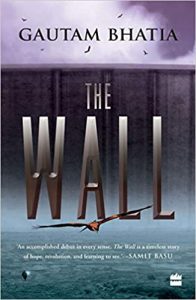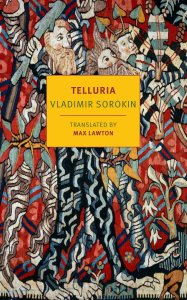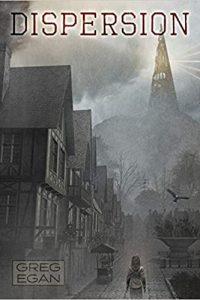Gary K. Wolfe Reviews The Wall by Gautam Bhatia
 The Wall: Being the First Book of the Chronicles of Sumer, Gautam Bhatia (HarperCollins India 978-93-5357-835-0, INR399, 386pp, tp) August 2020.
The Wall: Being the First Book of the Chronicles of Sumer, Gautam Bhatia (HarperCollins India 978-93-5357-835-0, INR399, 386pp, tp) August 2020.
The tale of a society long trapped in enforced stasis but finally destabilized by curious and rebellious youth is one of SF’s core narratives; think of Clarke’s The City and the Stars, Heinlein’s “Universe”, or even Collins’s The Hunger Games. The Wall, Gautam Bhatia’s first venture into fiction (he’s apparently a respected constitutional lawyer in India, as well as a contributor to Strange Horizons), at first seems intent on reducing this theme to its archetypal core, although Bhatia rather cleverly leaves open a number of SF trapdoors in a narrative that on its surface reads like classic fantasy. The city-state of Sumer has for thousands of years been surrounded by an enormous wall. No one knows what lies beyond it, and nothing enters or leaves the city except for giant birds called garudas, whose origins remain mysterious. But the circular wall encompasses far more than the city itself: lakes, farms, woodlands, and quarries provide enough food and materials to sustain the population – as long as it remains stable – and the river Rasa and its tributaries provide a continuing source of clean water. Although the city prides itself on its principles of free speech and an elected leadership (after an unpleasant experience with an authoritarian ruler some centuries earlier), it nevertheless enforces a rigid class hierarchy, with the neighborhoods organized into 15 concentric circles called mandalas, the poor living in the outermost circle nearest the wall and discouraged from mingling with the higher classes, even through such mundane regulations as marriage license fees. While there is a progressive faction among the ruling council and an organization of scientists called the Select, a repressive priesthood called the Shoortans ruthlessly enforces the orthodoxy of unexamined faith in the wisdom of the legendary Builders.
Given his eventual purposes, which have more to do with the politics of resistance and revolution than with epic fantasy battles, Bhatia wisely refrains from portraying Sumer as a grungy, off-the-shelf dystopia. The citizens are for the most part comfortable and well-fed, and most seem content, if chronically unable to imagine any alternative to the way they’ve lived for generations. For Mithila, the leader of a young group of dissidents called the Young Tarafians (named after an earlier dissident), perhaps the most damning thing to be said about the quality of life in Sumer is that it’s adequate – sustainable (even to the point of recycling the dead) but thoroughly unchallenging. The front-matter map (more useful than most fantasy-novel maps) looks like that of a medieval city-state or, perhaps more to the point, one of the ancient Sumerian walled cities; there simply isn’t room for growth or change, even though there are a few signs that resources are being depleted (such as the long played-out rock quarries), while the food supply mostly seems to consist of a single cultivated grain. This, of course, complicates Mithila’s arguments for exploring beyond the wall: she can offer no evidence that it might improve Sumer’s quality of life, nor deny the risks that it involves.
The danger in presenting such a schematic society is that it invites an equally schematic novel, but Bhatia skillfully manages to avoid this by focusing closely on Mithila, who only grows more fascinating and complex as the plot unfolds. The daughter of a respected sculptor (who will turn out to have a couple of secrets of his own), she’s haunted by the death of her brother Garuda, killed in a cave-in when the two of them were trying to find a subterranean path under the wall. Her relationship with her younger sister Minakshi, who has joined the Shoortans as a “priestess of the wall,” is badly strained, but she draws support from her lover Rama (gay romance is handled matter-of-factly) and from fellow Tarafians such as Alvar and Lamon. Even these characters sometimes seem taken aback by Mithila’s near-obsession with the wall, but that obsession is what really powers the novel, as it comes to represent a debate about the purposes of societal structures, the potential costs of security and stasis, and the importance of history (among other things, the power-hungry Shoortans oppose the very idea of written histories). While there are a number of well-paced action sequences involving near-escapes and discoveries of secret chambers and passageways, the story perhaps inevitably moves toward a kind of courtroom-drama climax, during which the Tarafians are at risk of being banned or even ostracized (one of Sumer’s most severe punishments).
I’m certain that The Wall reflects many aspects of Indian culture and history that escape my notice (I had to look up the Sanskrit word “smara” – defined in the novel as a kind of longing involving the mystery of the wall – to find out why its double meaning in the novel is so important), but there are plenty of echoes of Western culture as well; an old Sumerian legend is pretty much that of Icarus and Daedalus, and at one point Mithila describes Sumer’s constricted view of reality in terms that are exactly those of Plato’s parable of the cave. There are even hints of Genesis and Paradise Lost in the various speculations about the mysterious Builders – who clearly had a far higher level of technology than present-day Sumer – and what their intentions might have been in constructing the wall in the first place. Presumably, we’ll find these questions answered in subsequent volumes – the ending is an almost literal cliffhanger – but The Wall itself is a deeply intelligent and thoughtful intellectual adventure – one plot point even turns on interpretations of ancient poetry – that raises some fundamental questions in a strikingly original and provocative way.
Gary K. Wolfe is Emeritus Professor of Humanities at Roosevelt University and a reviewer for Locus magazine since 1991. His reviews have been collected in Soundings (BSFA Award 2006; Hugo nominee), Bearings (Hugo nominee 2011), and Sightings (2011), and his Evaporating Genres: Essays on Fantastic Literature (Wesleyan) received the Locus Award in 2012. Earlier books include The Known and the Unknown: The Iconography of Science Fiction (Eaton Award, 1981), Harlan Ellison: The Edge of Forever (with Ellen Weil, 2002), and David Lindsay (1982). For the Library of America, he edited American Science Fiction: Nine Classic Novels of the 1950s in 2012, with a similar set for the 1960s forthcoming. He has received the Pilgrim Award from the Science Fiction Research Association, the Distinguished Scholarship Award from the International Association for the Fantastic in the Arts, and a Special World Fantasy Award for criticism. His 24-lecture series How Great Science Fiction Works appeared from The Great Courses in 2016. He has received six Hugo nominations, two for his reviews collections and four for The Coode Street Podcast, which he has co-hosted with Jonathan Strahan for more than 300 episodes. He lives in Chicago.
This review and more like it in the January 2021 issue of Locus.
 While you are here, please take a moment to support Locus with a one-time or recurring donation. We rely on reader donations to keep the magazine and site going, and would like to keep the site paywall free, but WE NEED YOUR FINANCIAL SUPPORT to continue quality coverage of the science fiction and fantasy field.
While you are here, please take a moment to support Locus with a one-time or recurring donation. We rely on reader donations to keep the magazine and site going, and would like to keep the site paywall free, but WE NEED YOUR FINANCIAL SUPPORT to continue quality coverage of the science fiction and fantasy field.
©Locus Magazine. Copyrighted material may not be republished without permission of LSFF.








